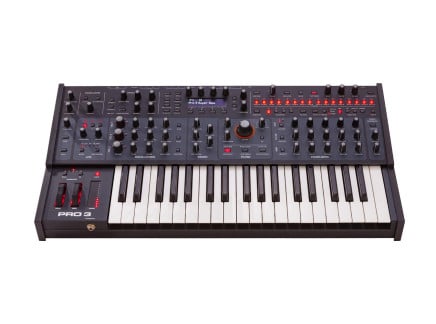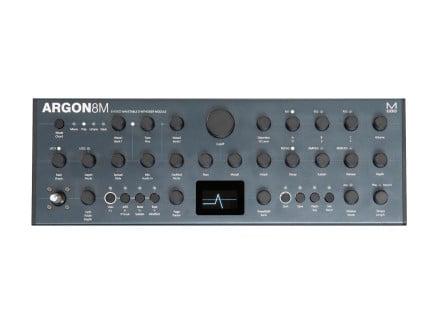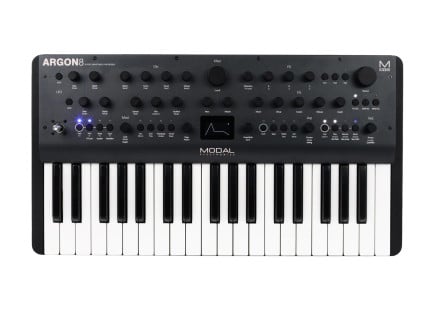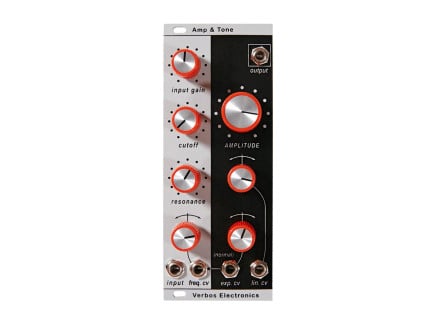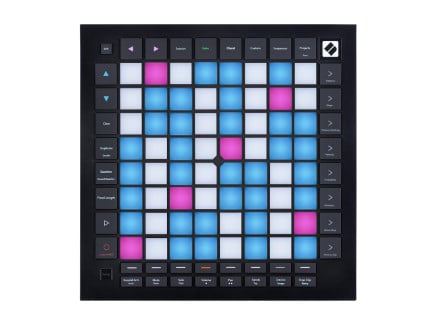It's that time of year again—NAMM. Several manufacturers have already announced new products for the year, ranging from Korg's reissue of the ARP 2600 to Earthquaker Devices finally breaking into the world of Eurorack synths with their Afterneath modular reverb. Keep your eyes on this page—we'll be updating it throughout NAMM with the latest videos and media of new synths, drum machines, and more.
Korg: 2600, Wavestate, MS-20, and More
Korg's new announcements this year have been striking—in the week preceding NAMM, they announced several new products that will interest musicmakers of all sorts. Of greatest interest to us, of course, were the new ARP 2600 FS, Wavestate, MS-20 FS, and SV2 digital piano.
The ARP 2600 FS fulfills a fantasy for many—a brand new, clean, ARP 2600 true in form to the original. When Korg reissued the ARP Odyssey in 2015, people immediately started to ask if a 2600 was in the works...and the answer for quite a long time seemed to be "no." We're excited that Korg seems to have listened in the long run, now reissuing a limited edition version of one of the best-loved synthesizers of all time.
The ARP 2600 FS maintains the same form factor and workflow as the original 2600: three wide-range oscillators, a huge-sounding filter, VCA, ADSR, ASR, stereo spring reverb, sample and hold, and tons of integrated voltage processing utilities. Their new take on the 3620 keyboard maintains duophonic operation and adds an integrated arpeggiator and 101-style step sequencer capable of storing and playing back sequences of up to 128 notes long. The 2600 FS also includes a flight case, perfect for keeping the instrument safe when on the road. Of course, the 2600 FS is at the moment a strictly limited release item...though and earlier image leak from Guitar Center seems to indicate that a smaller-scale and potentially more affordable reissue may be on the horizon as well. That said, if you're one of the lucky ones to have secured a 2600 FS, a ton of fun is sure to be in store.
The Wavestate takes a quite different approach from the decidedly old-school 2600: it updates Korg's classic Wavestation with modern features that will attract sound designers, film composers, or anyone looking for something markedly different from the many analog and analog-inspired offerings on the market. Based on digital synthesis concepts from the 1980s and 1990s, Wavestate brings unprecedented sonic definition to the world of hardware wave sequencing and vector synthesis.
Wavestate's sonic architecture is based around four PCM-based oscillators, each of whose timbres can be separately sequenced and animated by selecting from a huge array of internal wave shapes. These shapes include everything from natural instrument sounds to intense digital noise, and can be smoothly faded or instantaneously switched per oscillator—making for everything from seamless sonic transitions to jarring, edgy results. These oscillators can then be mixed via the front panel's joystick a la vector synthesis, a concept pioneered by the Sequential Circuits Prophet VS and then later adapted into Korg's Wavestation.
Wavestate also features several analog modeled filters, tons of integrated effects, and options for remarkably complex modulation inspired by the world of modular synthesis. Wavestate can sound like a full studio's worth of gear or it can sound like continuously morphing, smooth soundscapes—or countless completely foreign sounds.
The MS-20 FS came as a surprise—Korg has, of course, previously made a run of full-size MS-20 reissues as a kit...but there were extremely low quantities of these available, leaving many to ask why the MS-20 Mini would remain the only commercially available option when the full-size version (often praised for its more sturdy build quality) had already been developed and produced. It seems Korg is now finally answering that question: they are doing an additional limited-edition run of full-size MS-20s in four colors: classic black, white, metallic blue, and "khaki," a dark shade of green.
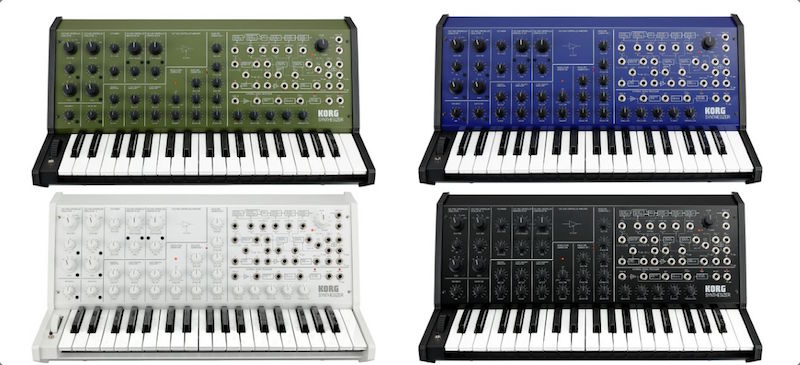 Four color options for the Korg MS-20 FS
Four color options for the Korg MS-20 FS
The MS-20, of course, is yet another cult classic in circles of synthesizer enthusiasts: when introduced in 1978, it was one of the most affordable synthesizers to ever hit the market. It offered a semi-modular architecture—normalled to perform typical monosynth keyboard duties with nothing patched, but capable of modular-style generative behavior and outrageous sonic experimentation. The MS-20's dual filter is one of the best-known aspects of its sound, as well as its External Signal Processor: a circuit which converts incoming audio into triggers, envelope follower CV, and pitch CV to allow users to control the synthesizer from external audio signals (a bizarre feature even in this day and age). No doubt a reissued MS-20 will find a lot of love in the synth community—adding USB and DIN MIDI input, it brings a taste of the 1970s into modern workflows, 1/4" patch bay and all. They're expected to ship in April, but there's no word yet as to a price or how many will be produced...but it's exciting news, regardless.
And then there's the SV-2: Korg's new adaptation of the stage vintage piano, available in both 73-key and 88-key versions. Based on the success of their prior SV-1, the SV-2 provides considerably greater sonic control than its predecessor (including user-configurable sounds, splits, and layers). It maintains the same RH3 graded hammer action and is available in both 73-key and 88-key versions. A welcome update to their flagship line of stage pianos, the SV-2 is a powerful tool for professional keyboard performance.
Also of note—the "leaked" photos of the Korg Opsix seem to be a "concept" instrument. Displayed only behind glass at Korg's booth, the Opsix appears to be a Korg take on the DX-7 concept: a six-operator FM synth with some updated UI controls which would seem to allow for easier programming and performance control. And while this instrument may just be a concept, it's one we'd love to see further explored.
Sequential Pro 3
Speculation has been high since Sequential registered a trademark for the Pro 3 in September of 2019—but we now can happily report that the Pro 3 exists and, for lack of better words, is awesome. Pro-2 owners will happily note that the Pro 3 is a pretty different beast altogether—and while there are definitely similarities between the designs, they each have fairly different strengths.
Like the Pro-2, the Pro 3 is a hybrid monophonic/paraphonic synth with CV I/O, extensive internal modulation options, powerful sequencing, and a huge modulation matrix. The Pro-3 has only three oscillators: two analog VCOs with standard waveshapes (each with continuous waveshaping potential) and one wavetable VCO (with 32 tables of 16 waves each). It features a multi-mode analog filter (with Prophet-6, OB-6, and transistor ladder modes), dual stereo digital effects processors, and plenty of options for adding some grit, including an analog drive, tuned feedback, and more.
Owners of the Pro-2 praise it for its intensely powerful modulation section—and the new Pro 3 stacks up here as well. It has three syncable LFOs with variable phase offset and slew, as well as five DADSR envelopes with optional looping operation. These combined with the 4 CV inputs and outputs, the 16-track/16-step/4-phrase note/modulation sequencer, two performance wheels, performance touch strip, and velocity and aftertouch-capable keyboard make the Pro 3 an endlessly flexible tool regardless your playing style. Whether you're looking for a killer new monosynth, a spacy chord machine, or a new centerpiece to your modular synth workflow, the Pro 3 just might be the synth for you.
Oh and of course, the Pro 3 is available in both standard and special edition versions—the Pro 3 SE provides all the features of the standard version, but adds a tiltable control panel and premium walnut trim, making it a lovely and striking presence in the studio or on stage.
Nord Wave 2
Nord's Wave 2 was an unexpected twist—a reimagining of one of Clavia's most interesting instruments. Released in 2008, the Nord Wave followed in the footsteps of their line of Lead instruments, providing a refined version of their analog modeling sound engine. However, the Wave had much more than just that: it could also do FM, wavetable synthesis, and sample playback—providing an uncommonly diverse collection of sound worlds for the player to choose from. And of course, one of the most interesting features of the Wave was its morphing capability: the ability to continuously interpolate between distinct sets of several front panel values, making for seamless, macro-level transitions between sounds. Additionally, it is bi-timbral—meaning that two different sounds could be layered.
The Nord Wave 2 expands the capabilities of the original Wave considerably. Wave 2 expands from the original's two simultaneous layers up to four, and provides extended versions of all of the original oscillator types: virtual analog, samples, wavetable, and FM. The Virtual Analog engine allows access to classic waveshapes, continuously variable shapes, combined waveforms, hard and soft sync, and white noise. The sample engine provides users high-quality samples from Nord's ever-growing Sample Library 3.0, and additionally allows users to import their own samples via the Nord Sample Editor 3 software. The Wavetable engine covers tremendous ground, while the FM oscillator engine provides harmonic and inharmonic 2, 3, and 4-operator FM algorithms. Wave 2 also includes a spectacular analog modeled filter and the stellar effects engine found in other Nord releases.
Wave 2 features similar parameter morphing as in the original, but allows Morphing access from even more control sources than before: velocity, aftertouch, wheel, and an external control pedal. Additionally, Wave 2 adds a polyphonic arpeggiator with advanced gating options, adding an extra layer of animation not present in the original. It also allows complex options for creating splits and layers, making it possible to construct timbres that continuously shift up and down the keyboard. The Wave 2 seems to check all the boxes absent from the original, and we're excited to hear more of what it can do.
Modal Argon8X and Argon8M
One of the most hotly-anticipated instruments of 2019, the Modal Argon8 seemed to come out of nowhere—an affordable, all-digital keyboard synth with its own thorough, well-considered approach to synthesis. One of the first in a recent wave of starkly digital synthesizers to emerge within the last half year or so, the Argon8 attracted people not only due to its feature set, but its remarkable price...a remarkably affordable price, given the history of Modal keyboards. But many users complained that the 37-key design wasn't enough to take full advantage of the instrument's sonic range...and so now, Modal introduces the Argon8X and the Argon8M, each geared toward a different style of musician.
Argon8X is a 61-key version of the Argon8, while the Argon8M is a keyboard-less, 19" rackmount/desktop version. Functionally the instruments are identical: eight wavetable-based voices, morphing resonant filter, eight-slot modulation matrix, integrated effects, parameter recording/sequencing, and more. Those who loved the clean, clear digital tone of the Argon8 but needed more keys or no keys at all can now celebrate—the instruments for them are expected to start shipping in March of this year.
Empress ZOIA Euroburo
No matter how you spin it, it seems fair to say that one of the most interesting new pieces of gear in 2019 was Empress's ZOIA, a multi-function device not altogether unlike a virtual modular synthesizer in pedal format. Empress's newest announcement, then shouldn't come as a surprise: the ZOIA Euroburo is a Eurorack format incarnation of the ZOIA, complete with 3.5mm I/O and four assignable CV inputs and CV outputs.
ZOIA's primary user interface is a grid of RGB-backlit buttons. These buttons represent internal virtual modules and their relationships to one another...so users of modular synthesizers should be fairly comfortable with ZOIA's workflow. It contains virtual modules that produce and process sound, interface modules for handling incoming and outgoing MIDI and CV, audio analysis modules, and virtual CV modules for modulating the behavior of other internal modules. By combining modules into complex networks, the ZOIA becomes a tremendously powerful modular system in its own right—and as such, becomes one of the most powerful pedals on the market.
ZOIA Euroburo takes the same workflow and internal sound engine and puts it into Eurorack format. Empress has indicated plans to release the Euroburo both as a module and as a module in a dedicated powered enclosure, making it a great addition to any modular system (whether in the rack or out of it). Pricing and availability info are still forthcoming, but we expect the ZOIA Euroburo to be an excellent expansion for virtually any modular setup big or small—whether in its capacity as a CV powerhouse or a strikingly rich sound generator and processor.
2hp's New Releases
2hp has announced several new products—as always, in quite small packages. This year, they have three new modules and a new lunchbox case, which has enabled the creation of several distinct and insanely small modular systems.
The three new modules are the Loop, Comp, and Pitch, each of course only 2hp wide. These provide useful effects distinctly uncommon in the Eurorack landscape: a looper, compressor, and pitch shifter, respectively. Loop is a sound-on-sound looper with and up to five minute audio buffer, with multiple modes and triggerable recording. Comp is a compressor with control for threshold, ratio, and attack and release times, with a sidechain input for linking the dynamic behavior of multiple audio sources (great for ducking effects and pulsing rhythms). Pitch is, as you might expect, a time-domain pitch shifter with flutter control, providing a great way to process either external audio or sound generated within the modular itself. With 1V/Oct pitch tracking, it is sure to provide an interesting approach to polyphony and signal processing in the modular. All with an expected Q2 release, Eurorack effect processing will surely become more interesting this spring and summer.
2hp's other big announcement is their Lunchbox: a 42hp powered Eurorack case built into...well...a metal lunchbox. Available powered or unpowered, the Lunchbox is an awesome and discreet Eurorack case perfect for compact setups. Full specs aren't yet available, but it looks like 2hp has plans to use this case as the basis for several systems. And while 42hp might not seem like much, consider just how much power twenty-one 2hp modules could provide.
Moog Subsequent 25
Moog unveils Subsequent 25—a paraphonic analog synthesizer that fuses elements of Subsequent 37 and Sub Phatty, and layers them with a state-of-the-art sound engine, and adds a completely redesigned preset management system. This combination results in a modern synthesizer with a vast sonic range, easily suitable for floor-shaking basslines, fierce leads, punchy stabs, and much more.
Each of the two oscillators in Subsequent 25 features four selectable waveforms: triangle, sawtooth, square, and pulse. The second oscillator can be detuned to up to seven semitones from the first, as well as hard-synced to it. On top of the two main oscillators, the synth also features an additional noise source, and a dedicated sub-oscillator tuned to track one octave below the first oscillator.
The built-in mixer allows for a seamless blending of these four sound sources in any desired proportion, and there is a twist. Turning mixer knobs clockwise increases the levels of sounds, reaching unity gain at a 12 o’clock position. Moving past that point gradually injects mild distortion, adding warmth and character to the signal that analog synthesizers are often so praised for.
It is difficult to imagine a Moog synthesizer without the signature transistor-ladder lowpass filter, and Subsequent 25 is certainly not lacking one. Right after the mixer stage, the signal enters the filter, making that classic Moog sound readily available. As it wasn’t enough the sound can be further shaped by the MultiDrive circuit, which can add anything from subtle saturation to full-on hard-clipping.
In terms of modulation, Subsequent 25 features two wide-ranging ADSR envelopes by default assigned to amplifier and filter respectively, and an LFO with five selectable waveforms: triangle, square, saw, ramp, and sample and hold. Internal routing provides access to control of the oscillator pitch, filter, and the waveform with attenuators for dialing-up the depth of modulation.
On top of being fully MIDI-controllable, Subsequent 25 features three additional CV inputs for pitch, amplitude, and filter frequency cutoff, making it easy to integrate into a variety of settings.
The synth ships with 16 presets evenly distributed across four banks. A dedicated software editor makes for a robust platform for creating custom presets that can be saved on the user’s personal computer and uploaded to the Subsequent 25 via a USB cable.
Earthquaker Devices Afterneath Eurorack
The acclaimed otherworldly reverb from Earthquaker Devices now comes to the land of Eurorack, and that means that your sounds can now be sent to even stranger and farther universes. The Afterneath module features nine controls, and four control voltage inputs accompanied by attenuverters.
The input control amplifies the incoming audio signal. The Dampen parameter is responsible for the filter cutoff frequency, with darker sounds achieved by setting the knob counterclockwise, and brighter tones are accessed by turning the knob clockwise. Turning up the Reflect parameter increases reverb regeneration, and forces the module to self-oscillate at extreme settings. The module also features a send and return i/o for the reverb reflection, allowing to insert other effects into the feedback path.
The Drag parameter adds a stuttering effect by separating the short delay clusters that form the reverb. The control has a drastic effect on pretty much all the aspects of the sound, and can function in one of several Modes: unquantized, unquantized with slew, unquantized 1V/Oct with an exponential response, chromatic, major, minor, pentatonic, octaves/fifths, and octaves. Finally, the Diffuse parameter adjusts the spread of the reverb, and Length determines its decay time. Additionally, the module features a Dry Kill button, which mutes the input signal completely.
Drag, Mode, Diffuse, Length can be manipulated by the external control voltage signals, which results in immensely dense textures that never seize to surprise. If the original pedal already was a unique and excellent reverb on its own, the Eurorack version significantly extends the palette and possibilities.
Noise Engineering's New Releases
With no momentum lost after releasing some helpful utilities and a whopping five different distortion modules late last year, Noise Engineering arrives at NAMM with three exciting module prototypes of some new and different things.
First up is Virt Iter, a new stereo oscillator with different modes and separate phase modulation on the left and right channels, which is sure to fit in well among NE's other oscillator offerings.
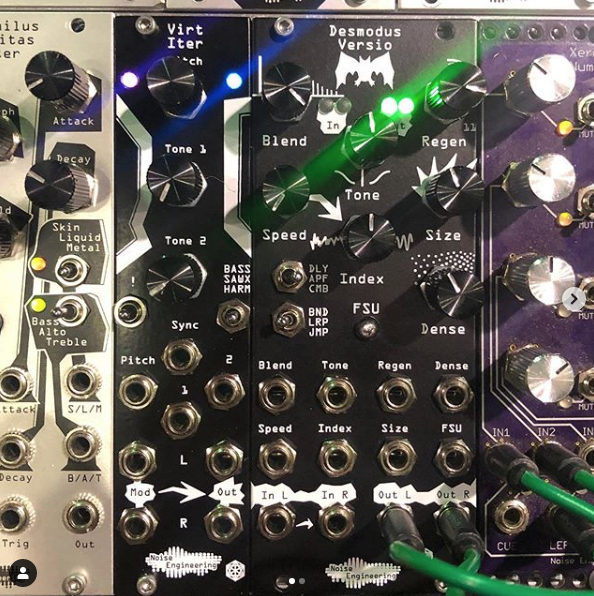
Univer Iter is a fully customizable MIDI-to-CV interface, with a free web app available to configure the 8 CV outputs in nearly any way you want. There is also TRS MIDI I/O, and the USB port that allows for communication with macOS and Windows systems, as well as iOS and Android devices.
Finally, the Desmodus Versio is the long-awaited Noise Engineering reverb module, containing a range of typical reverb sounds that can be pushed into the noisy, destructive places we've come to know and love from Noise Engineering. There are plenty of CV-able parameters to morph and mangle the reverberant space in wild ways. As these are prototypes, all prices and release dates are TBD, but we're sure that after NAMM, NE will return to diligently working on these exciting new modules to get them out into the world as soon as possible.
An especially intriguing aspect of Virt Iter and Desmodus Versio is that they utilize a new programming platform developed by Noise Engineering, allowing for easy upload of alternative firmware files to change them into totally different effects and voices. Noise Engineering teases that they already have some things in the works, so it's clear that the value and flexibility of each module will greatly increase as each one is released.
Erica Synth Bassline DB-01
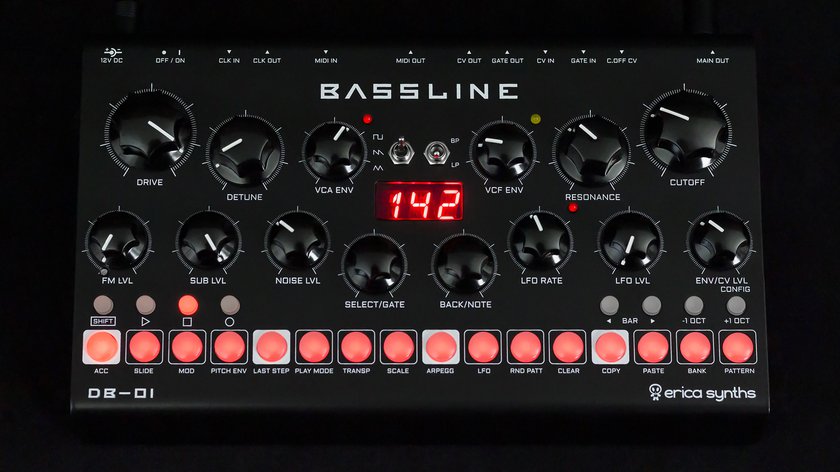
While you will not find Erica Synth at NAMM this year, this didn’t stop them from sharing the exciting news of the upcoming release of the standalone Bassline DB-01 synthesizer, set to be released this coming Spring. This versatile little machine is capable of generating a wealth of sounds, ranging from gritty basslines to drums, and even drones.
Essentially, the device is comprised of Erica’s signature analog synth voice and a very capable sequencer. It features the dynamic LP/BP filter design from the Acidbox, a transistor-based sub-oscillator, destructive overdrive, and a noise source. The LFO can be synced to MIDI or analog clock and offers multiple waveforms to choose from. Three dedicated envelopes allow for independent control over pitch, amplitude, and filter cutoff frequency.
The powerful onboard sequencer is highly intuitive and features a quantizer with a multitude of selectable scales, including some microtonal options. Sequences can be up to 64-steps long. Internal memory allows storing of sequences across four banks of sixteen patterns. Patterns can be randomized on the fly resulting in some unexpected arrangements. Furthermore, the sequencer contains a dedicated track for automating the cutoff of the VCF, thus opening doors to classic brain-melting acid lines.
If you are in Los Angeles are and feel intrigued by this machine, stop by our Post-NAMM Synth Meet on 1/20/20 to check it out, and even catch Erica’s own Ģirts Ozoliņš’ live performance.
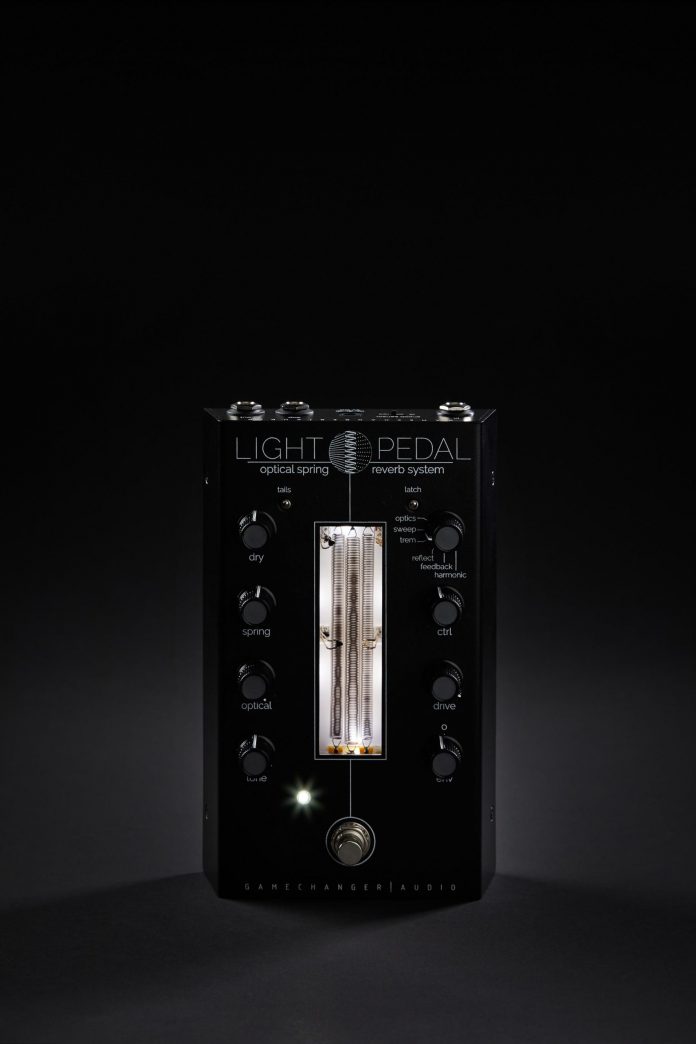
Gamechanger Audio Light Pedal
Gamechanger Audio crew seem to live up to their name with every new release announcement they make. While we patiently wait to get ahold of the Motor Synth, which was announced last year, a shiny new device was announced at NAMM 2020 bearing the mysterious name, the Light Pedal.
Light Pedal is the first of its kind fully analog optical spring reverb. It uses infra-red sensors to harness the full harmonic range of the built-in spring reverb tank, which results in a large spectrum of effects unachievable with other spring reverbs. The optical sensors are positioned at very specific points around the tank, which allows them to capture even the subtlest movements of the spring as soundwaves travel through it.
A variety of effects can be directly selected via the top right control parameter, including Optical Reverb Tremolo, Optical Reverb Modulation, Optical Harmonic Shimmer, and more. Although a lot about this pedal still remains mysterious to us, we can’t wait to spend more time with it.
New Modules from Verbos Electronics
We were lucky to be the first ones to hear about the new module announcements from Verbos Electronics during their recent clinic at Perfect Circuit. Nevertheless, as we are pretty excited about these releases we will mention them again here.
Amp & Tone is a slimmed-down version of the classic VCF+VCA combo module, previously know as Amplitude & Tone Controller. Reduced in size, the module still retains all the attitude it is so beloved for, which is sure to put a smile on the face of everyone who ever wanted to put it in their systems but couldn’t find the space.
Foundation Oscillator is the smallest oscillator in the Verbos family of modules, yet it is full of character. It features the traditional discrete transistor core from which the Triangle and Square outputs are derived, yet it also stacks three waveshaped outputs accompanied by the Timbre control that morphs each out from Sine to Saw, to Square, and to Buchla Music Easel-inspired Spike wave. It also adds a "richness" control which imparts a bizarre effect not unlike sync sweeps—with a distinctly edgy, intense character.
Noise & Filter packs a pink noise source and four-band fixed filter bank derived from the magnificent Bark Filter in a mere 4HP. Besides simply being an excellent utility/processor module, Noise & Filter also pairs really well with the Scan & Pan mixer.
New Releases from Qu-Bit
Coming in with four new designs at NAMM this year, Qu-Bit Electronix is once again showing off their unique approach to DSP processing, physical modeling voices, and CV generators.
For what promises to be a compelling take on reverb, Aurora is a spectral reverb, with freezing capabilities in both the time and frequency domain. This will allow you to capture incoming audio and stretch, warp, and blur it to ethereal new places. With stereo I/O and reverb time reaching all the way to infinite sustain, Aurora is sure to be a treat for drone and ambient aficionados.
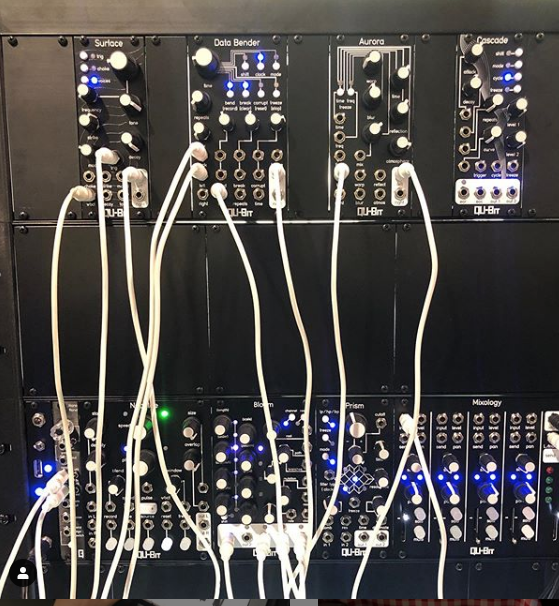
Specializing in broken and glitchy sounds, the Data Bender is designed to sound like failing audio equipment. Everything from neglected tape decks to CD skipping and software glitches can be found here. Its audio buffer is capable of recording up to five minutes of stereo audio, allowing the user to explore and lose themselves in a landscape of sonic defects.
Surface is Qu-Bit's newest voice for physical modeling sounds. Ranging the spectrum from realistic plucked and percussive to digital and FM inspired sounds, Surface also features stereo outputs and eight voices of polyphony. Fans of physical modeling will surely find much to explore within Surface.
Last but certainly not least, Cascade is the newest envelope generator from Qu-Bit. Based on a burst clock generator, Cascade also features two outputs of ratcheting envelopes, variable curvature, and end of attack and cycle gate outputs for both creating and reacting to complex modulation. There is also multi-mode functionality, allowing for cycling envelopes, ADSRs, dual AD envelopes, and even a gravity simulated "bouncing ball" mode.
All the new modules from Qu-Bit have us excited, and thankfully we won't have to wait very long. Surface, Aurora, Data Bender, and Cascade are respectively expected to release each month from March to June.
4ms Ensemble Oscillator
The Ensemble Oscillator is a collaboration between 4ms and Matthias Puech, who also designed their rather unique delay module, the Tapographic Delay. The Ensemble Oscillator contains 16 sine wave oscillators, which are quantized to a scale. These can be one of the 30 factory presets the module comes with, or you can add your own scales. This can be done by manually dialing in the frequency on the module's large knob, or with a CV/gate keyboard (or MIDI keyboard and MIDI to CV converter). While usually thought of just containing semitones, scales in the case of the Ensemble Oscillator are seen as a series of intervals or harmonics. The Ensemble Oscillator contains standard western scales like major triads and octaves and fifths, it also includes a free scale group. This contains non-octave repeating and microtonal scales such as Wendy Carlos' alpha and beta scales and Bohlen-Pierce tritave scales.
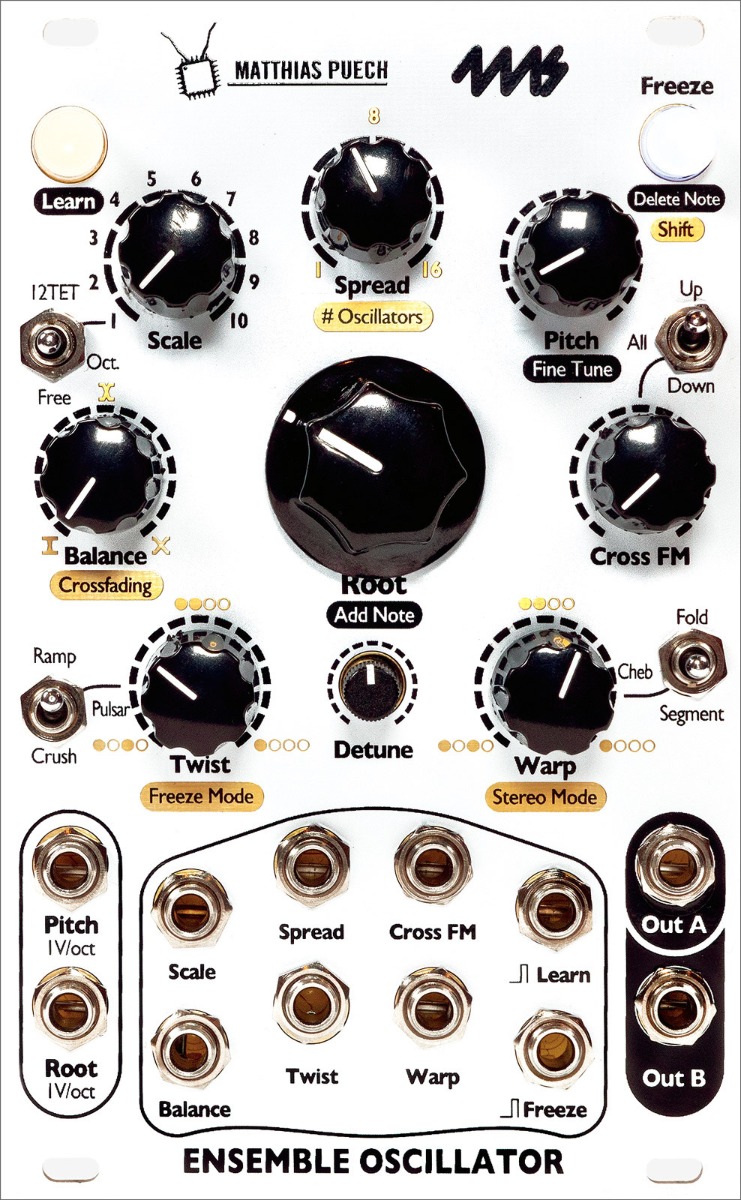
The root knob sets the pitch of the lowest oscillator, also known as the root note. Adjusting this will cause all oscillators to shift in frequency. The oscillators can be spread from this root note, providing a wider range of oscillator frequencies and harmonics. The pitch knob transposes the oscillators from the root note after quantization. At the maximum settings of root and pitch, the Ensemble Oscillator's frequency can pass the range of human hearing. The detune knob can be used to adjust the detune of the oscillators post-quantization and can be used for beat frequencies and dissonance. If used with the stereo outputs, it can be used in subtle amounts to create a lush stereo field.
The Ensemble oscillator can go from beautiful to harsh with the twist of a knob or the change of a modulation source. Three twist phase distortion modes distort the time base of the sine waves to more complex waveshapes, using a technique called phase-shaping. These include ramp, an increasingly steep ramp waveform that feeds the wave back upon itself; pulsar, which compresses the sine waves' phase into narrow pulses; and crush, which bit crushes the oscillator phase. The warp control is a wavefolder which changes the harmonic content of the waveforms. Fold is an analog inspired wavefolder; Cheb is a Chebyshev polynomial-based wavefolding algorithm; and segment is a triangle wave-based linear wavefolder. The oscillators can also FM each other, controlled by the Cross FM knob. Because all the oscillators are quantized to related frequencies, the resulting FM sounds created can be quite pleasant or extremely gritty, but harmonically interesting nevertheless.
4ms is known for their in-depth and versatile modules, there's nothing else on the market that recreated the kind of functionality baked into their modules. The Ensemble Oscillator provides deep sound shaping using three additive synthesis methods, CV over every parameter, and built-in quantizer with 30 preset scales with the ability to create your own. It sounds great and can change its character on a dime.
Novation Launchpad Pro Mk 3
Novation’s Launchpad became one of the most prized controllers to accompany Ableton Live pretty much since day one, and all of the incarnations of it steadily got better and more advanced. The newly announced Launchpad Pro Mk 3 is stepping in as the most powerful among its successors.
On top of an even more streamlined integration with Ableton Live, this version of the Launchpad can be used directly with the hardware in your studio via a built-in MIDI I/O. Speaking of an improved Ableton workflow, Launchpad Pro Mk3 lets you easily launch clips, and scenes, control mixer, transport, and devices, as well as perform indispensable tasks like duplicating patterns and doubling their lengths. There is even a button for the amazing MIDI capture, ensuring that no great idea gets lost.
The controller is equipped with a powerful four-track 8-note polyphonic 32-step sequencer with user-definable probability and mutation settings. Combined with pattern-chaining, this makes the creation of long evolving sequences a breeze.
On Launchpad Pro Mk 3 you will also find a few modes that make performing and producing with it inspiring and easy. Chord mode lets you construct and play complex chords, while not and scale modes activate the quantizer ensuring you will never hit a note outside the desired scale.
The physical aspect of the control also got a major improvement. The pads are now larger, and fully velocity- and pressure-sensitive. The body of the controller itself feels tough, yet still very lightweight making it perfect to travel with.
Chase Bliss New Releases
While prototypes of these designs were shown at last year's NAMM show, Chase Bliss has brought them back fleshed out, finalized, and ready for production, along with a new surprise.
After a successful Kickstarter campaign, the Chase Bliss Blooper is receiving a wider release this March. Turning the concept of a looping pedal on its head, Blooper is a creative looping device cracked open up for textural exploration and time travel. Utilizing two modifiers, the user can apply various effects to either the loop alone or both their input signal and recorded loops, combining effects like filtering, playback speed manipulation, and more to create complex, degrading loops.
One of the best creative features is the implementation of undo and redo–rather than a sequential process of removing additions, the Layers knob scrolls through up to eight levels of your loop, allowing you to revisit any particular musical idea if you find you've lost your way. Then simply record something new to clear subsequent layers, and venture out to a totally new place. Blooper also features the usual Chase Bliss features, with full MIDI implementation, expression and CV control, and plenty of dip switches to customize this bottomless looper to your needs.
The first in their Automatone series, Preamp MkII is a collaboration with Benson Amps. Having a robust design with motorized faders and several multi-mode switches, Preamp MkII can recall settings instantly with its stored parameters in up to thirty presets. With its wide range of fuzz, EQ, and clipping circuit options, guitarists and synthesists alike on the search for a high-end, flexible preamp and overdrive may find a tonal home in this pedal.
Finally, the newest design unveiled just before the start of NAMM 2020, the second Automatone is the CXM 1978, created in collaboration with Meris. It's a compact, modern recreation of the Lexicon 224, a studio reverb from 1978, as you might assume from the name. Although it has contemporary 32-bit AD/DA converters, the CXM 1978 features adjustable clock speeds, with Hifi, Midfi, and Lofi options for anyone looking for a range of reverb sounds from modern to vintage.
The pedal also has three classic reverb algorithms for room, plate, and hall spaces, EQ, pre-delay, and a sculptable decay crossover, all allowing you to shape your reverb as you please. And like the previous entry in the Automatone series, CXM 1978 features recallable presets and motorized sliders to instantly revisit previous spaces. The price is still TBD, but expect this one to find its way out into the world later this summer.
Pittsburgh Modular's Cascading Delay Network
The Pittsburgh Modular Cascading Delay Network is a four-channel analog delay network, that has four inputs, eight routing modes, seven outputs, and two CV inputs. Each channel has up to 600ms of delay, but can be lengthened with a jumper on the back up to 2.8 seconds. While the delays are clean when using the standard delay times, it will lose audio fidelity at the longer delay times. The delays can act independently (with separate inputs and outputs), however where the real fun begins is the cascading modes.
There are eight routing modes; all four cascading together with one feedback path, all four cascading with multiple feedback paths, three grouped with one feedback path and one independent, three grouped with multiple feedback paths and one independent, two pairs, two pairs with multiple feedback paths, two normalized and two independent, and four independent delays. When cascading together, the delay times are summed together for one long delay. With one feedback path the input level controls the feedback amount and with multiple feedback paths the repeats knob sets a per-delay feedback amount. This can get out of hand pretty easily, so a light touch is suggested when using multiple feedback paths.
There is internal normalization, so with nothing patched into an input, the previous input is present at that delay, without the need to split or mult the input signal. There are two CV inputs that control all four channels with per-channel attenuation of the CV input. There is internal normalization between the two CV inputs, with nothing plugged into the right CV input, an inverted version of the CV will be present to modulate the four delays. In addition to the individual outputs per channel, there are three mixed outputs. These are channels one and three mixed, channels two and four mixed, and a sum of all four channels. Using the two mixed channels allows for a great stereo spread, especially when combined with inverted and non-inverted CV modulation of the delay times. The Cascading Delay Network can do everything from bright and warm delays to feedbacking madness and everything in between.
Additionally, Pittsburgh is releasing the SV-1b. The SV-1b is a repanel of their SV-1, now with new buttons and with a stylish black panel. The SV-1 is Pittsburgh Modular's much loved synthesizer voice. It is an all-in-one semi-modular subtractive synthesizer with MIDI to CV, two oscillators with sub-oscillators, modulation LFOs, sample and hold, mixer, ADSR, VCA, and filter with highpass, bandpass, and lowpass outputs. Now matching the rest of the Lifeforms line of modules, the SV-1b brings all the functionality and great sound found in the original SV-1.
Pittsburgh also presented a new Lifeforms series waveshaper, the Organic Waveform Designer—based on the oscillator shaping section in their Voltage Research Lab synthesizer.
Sonicware Liven 8bit Warps
The makers of the ELZ_1 present their next synth in a new series they're calling Liven, designed with a focus on live performance. Sonicware's new Liven 8bit Warps is a portable yet full-fledged 8-bit synth and sequencing machine.
8bit Warps features four wave-memory synth engines: Warp, Attack, Morph, and FM, and the flexibility to be polyphonic or monophonic with legato or unison modes. There's also a multi-mode filter, LFO for pitch or filter modulation, and several built-in effects, including chorus, flanger, delay, and hall and plate reverbs. Like its predecessor, the 8bit Warps can be powered with a 9V PSU or AA batteries and has a built-in speaker as well as a headphone output and line-level I/O.
Being designed with live performance in mind, 8bit Warps comes with a feature-filled 64-step sequencer. It's capable of recording live performances or entering in steps manually, as well as automation of parameters per step. There are also arpeggiators for the synth engines, and an audio looper. And for connecting with other gear, there's I/O for sync and MIDI, making it a capable component of a multi-piece live performance setup.
Still in development and currently funding on Kickstarter, the first batch of 8bit Warps is expected to ship in June 2020.
Blipblox After Dark, Now for Adults
After the kids go to bed, the Blipblox After Dark comes out to play. Retaining the same signal flow as the original Blipblox, the After Dark version adds additional functionality that makes it a fully fledged synthesizer. It still has the sequencer, which at the touch of a button randomly generates a new sequence, but adds over 100 new sequences. The new wavetable oscillators use 256 ROM-based warveforms that can be morphed and scanned using the modulation sources. The new resonant multi-mode filter adds warmth and richness to the sounds and has lowpass, bandpass, and highpass modes. The multi-tap stereo delay adds space and character that really makes the Blipblox come to life. It also boasts an impressive drum section with hundreds of drum samples that can be individually tuned to your needs.
The biggest change is the addition of labels on the controls. The original Blipblox doesn't have clear indications of the knob functions as it was designed for kids. Without clear indications, users don't have any preconceived notions about the functions of the synthesizer. This can be fun and rewarding, but often leads to just random knob turning without any idea of what is happening. Now that you can see what's going on, recreating sounds is easier than ever. Speaking of recreating sounds, the settings of the Blipblox After Dark are retained over power cycles, allowing you to come back to the same sequence and oscillator settings when you boot the unit up next. The Blipblox After Dark brings the same hands on and inviting interface with the addition of more serious synthesizer functions, and clear indication of panel controls.
Walrus Audio D1 High-Fidelity Stereo Delay + Julia V2
Walrus Audio didn't show up to NAMM 2020 empty-handed, bringing with them an exciting new delay pedal and an update to one of their most beloved modulation pedals.
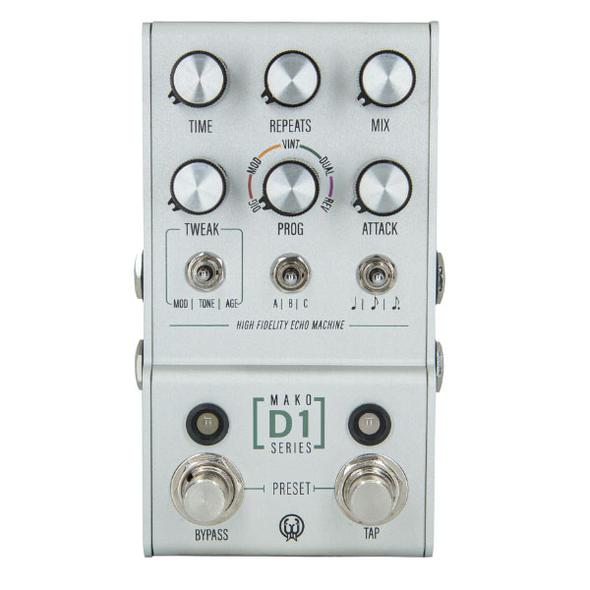
The D1 High-Fidelity Stereo Delay is a feature-packed and super flexible delay pedal, the first in their new Mako series of effects. There are five delay programs here: a crisp and clean digital delay, a heavy modulated delay, vintage-inspired delay, dual parallel delays, and reverse delay.
Further sculpting of each program can be achieved by dialing in modulation, tone of the delay repeats, and quality of decay, and these settings can be saved to one of nine onboard presets. In need of more presets? There's also MIDI support for up to 128 presets, in addition to full control of all parameters and delay time. For more flexibility, delays can be set to quarter, eighth, or dotted eighth divisions of the tap tempo, and the stereo I/O can be combined in any configuration of mono or stereo uses.
Also new for 2020, Walrus has updated their modern classic chorus pedal. The Julia V2 maintains the same fully-analog sound of the original, but now has new artwork, jacks relocated to the top of the pedal, and a new soft bypass switch for smoothly engaging lush, warbly chorus and vibrato.
Old Blood Noise Endeavors Visitor + Fault V2
For those looking for a different take on a modulation effects pedal, OBNE also presents their new Visitor Parallel Multi-Modulator pedal. Inspired after designing their recent Signal Blender effect mixer and router, Visitor is a self-contained, dual-channel modulation pedal.
The primary channel allows selection between tremolo, phaser, and chorus effects with independent controls. While the secondary channel only offers a choice of tremolo or chorus, its single macro control affects several parameters at once, and internal connections with the primary channel create complex interactions between both effects.
The updated Fault V2 maintains much of the core sound and features of the previous model but brings a couple of very welcome additions to increase the versatility of this overdrive and distortion pedal. Namely, Gain1 now has a boost toggle to set the pedal in one of two different gain ranges, allowing for use as a clean boost or pushed up into higher gain overdrive.
Another new switch, fittingly named Crush adds in another stage of clipping after the EQ, making the Fault V2 fully capable of distortion, destruction, and decimation.
Frap Tools Brenso Complex Oscillator
The Frap Tools is a complex oscillator that pushes the concept of a complex oscillator into new territory with an extensive selection of shaping and modulation options. It is comprised of four sections, two for sound generation (green and yellow) and two for sound processing (red and white). The green and yellow sections each feature triangle-core oscillators with four outputs. They offer both exponential FM and linear thru-zero frequency modulation (TZFM) at the same time with manual adjustment of modulation depth and deviation. Thru-zero frequency modulation allows the oscillators to run backwards into negative frequencies, folding the waveform over onto itself. The super handy coarse frequency lock disables the coarse frequency knob. This is perfect for live use when you don't want to knock your oscillator out of tune. The fine tune is still available for fine adjustments of the pitch.
The processing part has both amplitude and waveshaping sections. The waveshaping section features waveshaper, PWM circuit, and two wavefolders. The waveshaper goes from sine to triangle to a logarithmic waveform. The PWM and waveshaped outputs are mixed together and then routed to a wave folder with symmetry control. The wavefolder also features an input for external trigger signals. When it receives a trigger signal, the wavefolder opens above its maximum level and then closes again with a non-linear slope, the length of which can be adjusted. This is great for percussive sounds with an organic delay. The resulting shaped waveform is finally passed to the red amplitude modulation section, which can operate in either balanced amplitude modulation or unbalanced ring modulation.
The green channel acts as the semi-normalled modulation oscillator and can be used in low frequency mode for complex LFO behavior. There are four modulation busses, two for frequency modulation, one for timbre, and one for amplitude modulation. By default, the sine wave from the green oscillator is normalled to these buses, but can be overridden by inserting a patch cable into the corresponding jack. The modulation bus features a VCA for global modulation depth. The Brenso takes inspiration from the classic Buchla 261 complex oscillator but is far from a clone, adding new functionality, more modulation options, and a pluckable wavefolder.
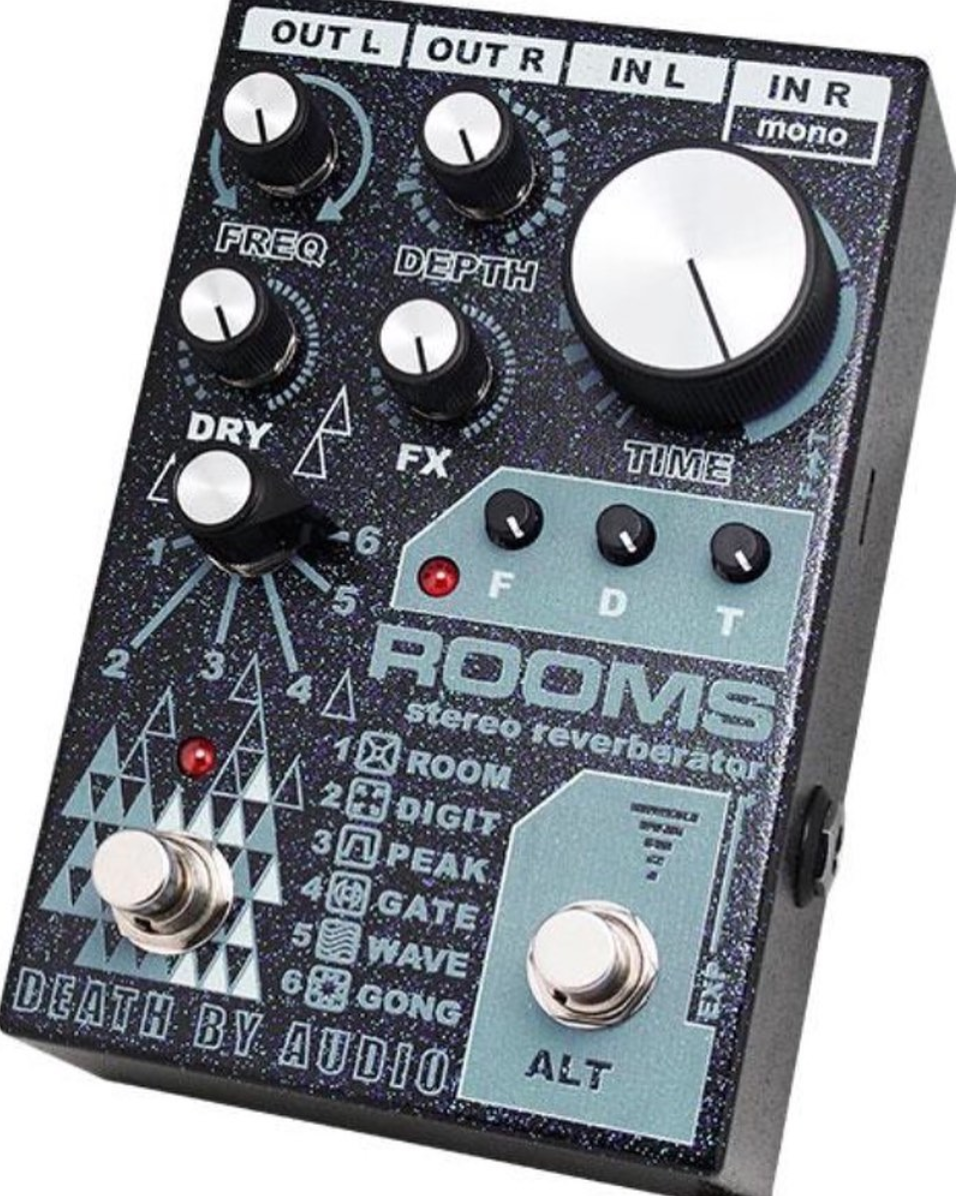
Death by Audio Rooms
No strangers to weird and compelling effects processors, Death By Audio is showing off their new Rooms Stereo Reverberator. Featuring six reverb modes ranging from semi-normal to far-out and heavily modulated spaces, each program has its own Frequency, Depth, and Time controls for modulating and warping aspects of pitch and amplitude in different ways per mode.
There's also the ability to set secondary settings of Frequency, Depth, and Time with an Alt switch, allowing for momentary changes in space to throw listeners for a loop. With expression input as well, Rooms is sure to be a hit for those looking for very atypical reverbs and unstable ambiances.
Akai MPC One, an MPC for the Masses
The MPC One is the newest member of the MPC family, retaining the same OS, FX, instruments, and multi-gesture touch screen as its bigger siblings in a smaller package. It can act as a controller or can be used as a standalone device. Not just made for beat making, the MPC One is a fully fledged synthesizer, capable of making whole tracks. The MPC One features stereo out and in with the ability to record and sample audio from external sources. Repitch, splice, morph, and reinvent your samples using the internal sampling engine. The pads can be used for laying down beats or playing notes, with the ability to quantize the pads to scales, making playing melodies a breeze. Connect to external MIDI gear with the MIDI in and out on five-pin DIN MIDI. It can also act as its own USB host, allowing you to use USB MIDI devices without the need for a host computer. Modular users rejoice, the MPC One features CV and gate on four 3.5mm TRS jacks for up to eight outputs to integrate with your modular or semi-modular gear.
It has the classic grid of velocity and touch sensitive RGB pads that the MPC line is known for. Although it is smaller, many of the key parameters are accessible on the panel as buttons, allowing for a quick workflow and access to the most important settings and features. When you do get into menus, there's no need to scroll with an encoder through endless parameters, the touch screen allows for easy navigation. The touch screen also makes creating sequences and automation changes fast and intuitive. Draw automation curves and lay down a sequence on the piano roll in seconds. It has 2GB of RAM and 4GB of internal storage with SD card slot for additional storage. The ethernet port on the back of the unit allows you to connect to your computer or router and easily integrates with Ableton Link or your Splice library. The MPC One is a killer sequencer and all-in-one music making box. It can be a brain to run the rest of your external gear, interface with your computer, and/or simultaneously sequence the internal instruments.
AMS Neve RMX16
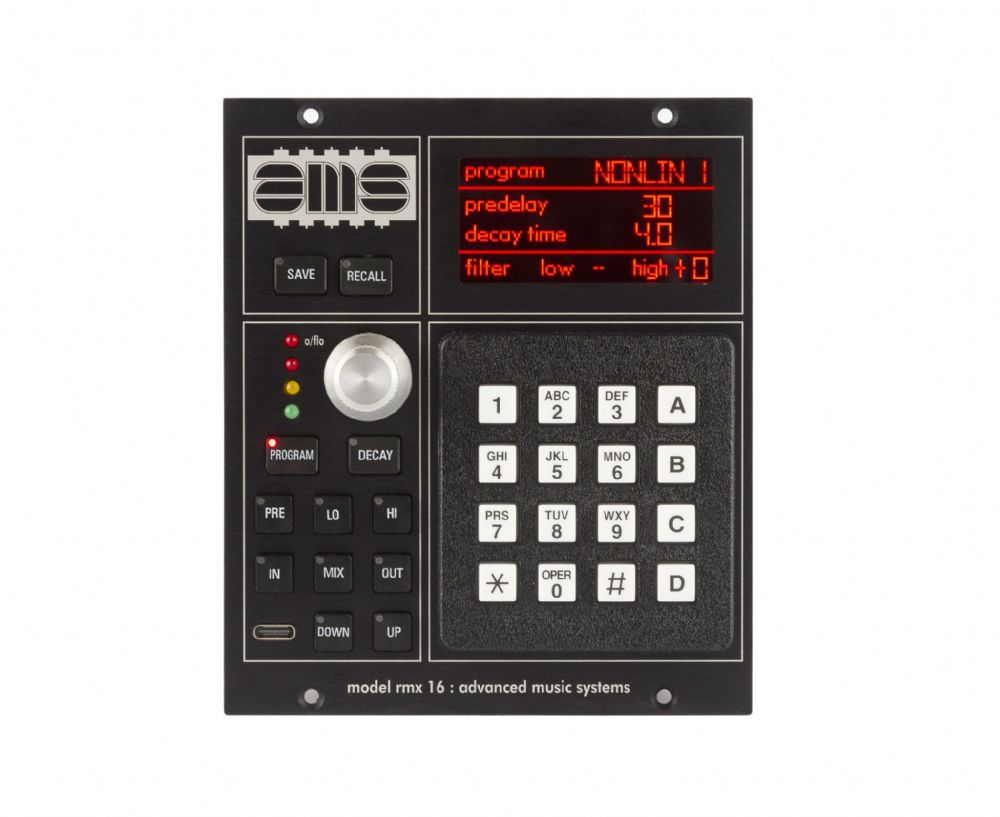
The AMS Neve RMX16 is a 500 series recreation of one of the most famous reverbs from AMS Neve, the 1982 RMX16. The RMX16 was the world's first microprocessor-controlled full bandwidth digital reverb and defined the sound of 1980's. Since then it has found its way into many recording studios, acting as the reverb centerpiece.
The new RMX16 features the original nine algorithms and the nine aftermarket algorithms for a total of 18 unique reverb types. The new features include rotary encoder, a mix/blend control, and large display which clearly indicates all relevant reverb information. The RMX16 allows for full independent control of each reverb's reverberant parameters for deep sound customization. The rotary encoder and nudge buttons allow for fine control of the reverb settings. It has a dynamic range of 90dB and an 18kHz bandwidth that allows it to excel as a high quality delay line. Up to 100 presets can be saved and recalled for ultimate flexibility. The RMX16 is a beautiful sounding reverb with a wide range of sounds that allows for deep control and preset management, bringing the sound of the 1980's into the 2020's and updating it accordingly.
Doepfer's Newest Modules
The Doepfer A-174-4 is a joystick, and oh boy is it a joystick. The massive joystick adds a new axis of control not usually found on a joystick, the Z plane. The Z plane is a rotation of a ring on the joystick itself. This allows for three dimensions of precise control using a single module. Additionally, a button on the top of the joystick allows you to fire off a gate at the press of a button. Each axis has offset and an inverted and non-inverted CV output. There are additionally four quadrant outputs which correspond to the corners of the joystick's position. These become positive when the joystick enters that corner and are especially useful for quadraphonic panning. Great for sweeps and gestures, the A-147-4 provides expressive control to your modular.
The A-130-8 is an eight-channel VCA and mixer. It features eight channels of independent VCAs, which each feature a simple interface of an input, output, and CV input. Additionally, three mix outputs are available on the bottom of the module. These output channels 1-4, 5-8, and a summed mix of all channels. You know the saying, you can never have enough VCAs, and the A-130-8 provides a cornucopia of VCAs, rejoice!
Arturia Keystep Pro
Combining and expanding on features from their highly popular Keystep and Beatstep Pro controllers, Arturia's latest piece of hardware is the Keystep Pro, a highly featured keyboard controller with impressive hardware I/O and what looks to be Arturia's most powerful sequencer to date.
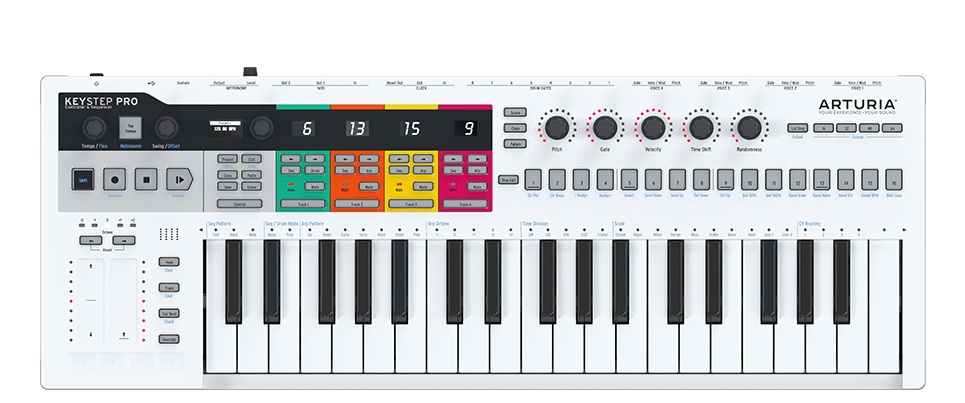
There are four tracks, each with up to 64 steps, but now the Keystep Pro adds the ability for up to 16 notes of polyphony per step. Each sequencer track can be freely routed to the Pitch, Gate, and Mod CV outputs on the back, or can be routed to the MIDI or USB outputs. All sequencer tracks have the ability to be recorded in real-time with overdubs, or entered manually with step recording and editing modes.
One track of the sequencer is also able to be configured as a 16-part drum sequencer, with eight physical drum gate/trigger outputs on the back. For those worried about being able to keep track of their drum sequences without visual feedback on pads like the Beatstep Pro, fear not–the 37 keys have individual LEDs above them to help you keep track of what's going on.
The other three tracks can be arpeggiators, with seven different arp patterns and up to a five-octave range. And like its sequencer and drum machine predecessors, each melodic and each drum track are capable of their own independent step length, allowing for quick and easy polyrhythm capabilities. There's also a general control mode, where the five encoders transmit CCs, and can themselves be sequenced and automated, offering no shortage of flexibility in however you need to use the Keystep Pro.
Promising to be a great solution for a keyboard-based hub in a studio full of various hardware and software tools, the Keystep Pro is expected to be available in March of this year.
Bastl & Casper Electronics Waver
The newest module collaboration from Bastl Instruments and Casper Electronics is here: the Waver wave folding mixer and disrupter of signals. On the surface, it begins no different than a typical mixer, having three DC-coupled inputs, two CV inputs, and a mix output allowing for use with both audio and control-rate signals. Channels A and C contain bipolar VCAs with attenuverters, offering level control and inversion to incoming signals. Ring modulation is also achievable with audio rate signals into the CV inputs.
Where Waver breaks from the norm of other mixers is in the Shape section, incorporating a wavefolder and square shaper into the mixer. The interaction between mixing signals at different levels and adjusting the clipping and folding points of Shape yields interesting interactions of dynamics and rich harmonic content. Abrupt phase cancellation and gating, and dense, aggressive wavefolding are the specialties of the Shape section
Fans of the feedback chaos of Dark Matter, the previous Bastl/Casper collaboration, will find familiarity in Waver's Break section. Offering both Dc-offset clipping and feedback by routing output of Shape into the input of Break, incoming audio can be pushed into new, destructive places beyond recognition. Eurorack users looking to combine several sounds for many flavors of harsh and aggressive timbres would find Waver to fit their needs exceptionally well.
Korg Nu:Tekt
The Korg has a new, special DIY division, Nu:Tekt. The Nu:Tekt platform is a series of development platforms that allow you to make custom synthesizers and effects. These use the same engines that are present in Korg's Minilogue XD and Prologue, but in a much smaller package. The Korg Nu:Tekt NTS-1 came out last year, a small, inexpensive synthesizer that allowed for a wide range of sounds in a small package. A new faceplate can be added to an existing NTS-1, which adds additional control and the ability to add a screen to allow more direct, visual representation of data and settings.
Additionally, Korg is releasing an effects pedal platform, which brings the effects section of the NTS-1 platform and puts it in a stomp box. These allow you to reprogram the existing effects in the stomp box to allow for a wide range of functionality. Another line of pedals by Korg's Nu:Tekt division is a series of effects pedals that use Korg's NuTube technology. The NuTube is a modern reinvention of the vacuum tube which imparts the same kind of warmth to a signal, but is much more reliable. Korg's Nu-Tekt division was developed with an eye towards the DIY market and their first forays into the market look exciting.
Roland Jupiter-X
Roland brought a full-size Jupiter-X, to much fanfare. The Jupiter-X uses the same engine as in the Jupiter-Xm but adds a 61-key keyboard with aftertouch and more front panel controls. It uses the Zen Core engine, also used in the Phantom, MC-101, MC-707, and AX-Edge. Patches done on compatible Zen Core products can be transferred to the Jupiter-X.
It can model classic Roland products such as the Jupiter-8, Juno-106, JX-8P, SH-101, XV-5080, and RD stage pianos. Plus, the Jupiter-X features a selection of drum machines such as the TR-808, TR-909, CR-78, TR-606, and more. The I-arpeggiator uses artification intelligence that reacts to your playing style and adds an accompanying drum track and synthesizer lines. Many of the knobs have been swapped out for sliders, harkening back to the look of the original Jupiter 8. A second, assignable envelope has been added, as well as an oscillator mixer section to blend multiple oscillators, with a selection determined by the current engine. It can have up to 256 note polyphony, depending on what model you're currently running. The Jupiter-X also features stereo outputs on a pair of TRS and a pair of XLR. Whether you're looking for the sound of 80's Roland analog products, modern piano sounds, or EDM bass and melodic lines, the Jupiter-X brings all this and more to the table.
Rhythmo BeatBox, Cardboard MIDI controller
The Rhythmo BeatBox is a low cost MIDI controller, made with the spirit of DIY in mind. All the parts come in a cardboard box, which doubles as the case. Although you have to put it together, no soldering is involved, just hooking up the wires.
The BeatBox features 24 assignable buttons with 16 laid out in the traditional pad sampling manner and eight more assignable buttons to the side. These include a shift button which allows the buttons to have a secondary function. The buttons are assignable based on whatever host program you're using to run it. Four encoders can be assigned to any CC parameter for hands on control. The XY joystick can be used to navigate menus or be assigned as another source of MIDI messages. Rhythmo has also made a companion app that works with mobile devices. Using the app you can upload samples, customize layout, loop beats, and adjust levels. The BeatBox comes with a built-in soundcard, speakers, and batteries that allow it to act as a standalone music source. The BeatBox serves as a great way to get into music making, it's easy to put together and offers hands on control of your DAW or with the companion app.
UDO Super 6
UDO showed off the newest iteration of their Super 6, a polyphonic, hybrid analog/digital binaural keyboard. It uses FPGA-based digital oscillators and a voltage controlled analog signal path. Its architecture is based around binaural or stereo operation. The phasing and panning of the oscillators can be controlled for lush and complex stereo imaging. It can contain up to 12 voices, or six super-voices with stacked oscillators.
The first oscillator is a wavetable oscillator that allows you to animate the waveforms and phase for extremely full sounds. Custom waveforms and wavetables can be added to the Super 6 for all new oscillator sounds. Oscillator two is an analog modeling oscillator that features the classic analog waveforms, hard sync, and pulse width modulation. The core of the LFO is the same as oscillator one, and can go up well into audio rate, acting as a third sound source. The oscillators are routed to both a highpass and lowpass filter, both of which are analog. The lowpass filter is an SSM-based resonant, four-pole lowpass filter that can both track the keyboard, self-oscillate at high resonance settings, and can be used in stereo. When used in combination, the two filters can act as a dual peak bandpass filter. After the filter, the analog signal path continues with an analog VCA. After the VCA, the sound is passed into the effects section.
The effects section contains 192kHz/24-bit delay and chorus which give even more depth and life to the stereo imaging. Each voice has its own modulation section with an assignable 8x8 modulation matrix to route the modulation sources to a variety of destinations, giving deep sound design capabilities. Additionally, it has an arpeggiator and sequencer onboard, as well as a four-octave, velocity-sensitive fatar keybed with aftertouch. It also has MPE capability, allowing each of the voices to have individual, per-voice animation. The Super 6 is inspired by the synths of yester-year but has been designed with an eye towards the future, building upon older ideas and innovating upon them.
NAMM 2020 was a whirlwind, with tons of new synths, pedals, controllers, modules, and more. We expect this will just be a taste of all the excitement to come in 2020, though—so here's looking forward to the future!


